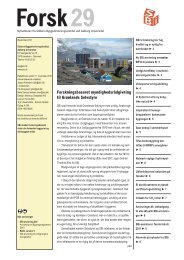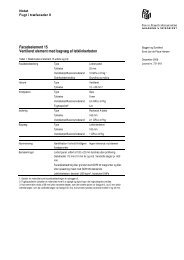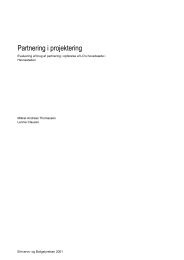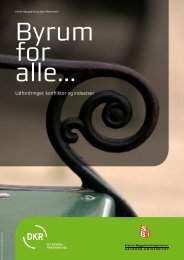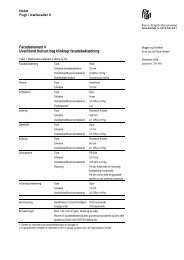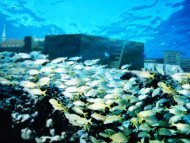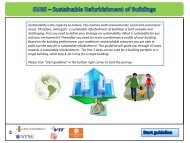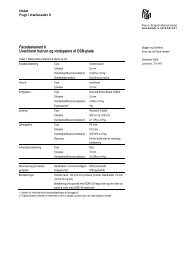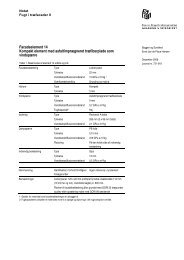Mould growth on building materials - Statens Byggeforskningsinstitut
Mould growth on building materials - Statens Byggeforskningsinstitut
Mould growth on building materials - Statens Byggeforskningsinstitut
You also want an ePaper? Increase the reach of your titles
YUMPU automatically turns print PDFs into web optimized ePapers that Google loves.
P. brevicompactum was the most frequently isolated Penicillium, c<strong>on</strong>firming results from the<br />
<strong>on</strong>-going Danish School study, where P. brevicompactum, P. corylophilum and P. chrysogenum<br />
were the most comm<strong>on</strong> penicillia.<br />
These results c<strong>on</strong>tradict results from North America, reporting P. aurantiogriseum and P.<br />
viridicatum as the most abundant Penicillium species. This might be due to misidentificati<strong>on</strong><br />
with P. palitans and other species from the aurantiogriseum-complex (J.C. Frisvad, pers<strong>on</strong>al<br />
communicati<strong>on</strong>), but unfortunately it has not been possible to obtain any of these Penicillium<br />
isolates to verify the identificati<strong>on</strong>.<br />
4.2 Fungal <str<strong>on</strong>g>growth</str<strong>on</strong>g> <strong>on</strong> <strong>materials</strong><br />
In papers 2 and 3, material samples were water-damaged (aw ≈ 1) and significantly higher<br />
number of spores were applied to the <strong>materials</strong> than naturally found in <strong>building</strong>s. The moulds<br />
were usually able to cover the <strong>materials</strong> where they occur "naturally" within 4-10 days, clearly<br />
dem<strong>on</strong>strating that when water damages occur, acti<strong>on</strong> should be taken the same day if <strong>materials</strong><br />
should be saved. This also complies with observati<strong>on</strong>s by several c<strong>on</strong>sultant engineers<br />
(M. Ø. Hansen, pers<strong>on</strong>al communicati<strong>on</strong>), who report complains from the inhabitants<br />
within 10-30 days after a single water damage, and complaints within 2-4 days in <strong>building</strong>s<br />
with a known water damage history.<br />
When using lower aw (papers 10 and 13) the <str<strong>on</strong>g>growth</str<strong>on</strong>g> rate decreased dramatically and with<br />
very few excepti<strong>on</strong>s <strong>on</strong>ly the primary and sec<strong>on</strong>dary col<strong>on</strong>isers were observed growing <strong>on</strong><br />
the <strong>materials</strong>. At stati<strong>on</strong>ary c<strong>on</strong>diti<strong>on</strong>s (paper 10), <strong>on</strong>ly Penicillium and Aspergillus species<br />
grew, with P. chrysogenum and A. versicolor being the most comm<strong>on</strong> species. However <strong>on</strong><br />
wooden <strong>materials</strong> A. flavus and Eurotium spp. were observed quite frequently and always<br />
with significant biomass. At 5°C <strong>on</strong>ly P. chrysogenum and A. versicolor grew, with the latter<br />
producing c<strong>on</strong>idiophores with very few c<strong>on</strong>idia.<br />
Wooden and wallpapered <strong>materials</strong> supported <str<strong>on</strong>g>growth</str<strong>on</strong>g> down to 78% RH (paper 10), which<br />
was lower than the other <strong>materials</strong>. It was seen that the planned pinewood was usually not<br />
infested <strong>on</strong> as much of the surface as the rough <strong>materials</strong>, but <strong>on</strong> the areas where <str<strong>on</strong>g>growth</str<strong>on</strong>g><br />
1<br />
5 cm<br />
Figure 6. C<strong>on</strong>crete after 4 m<strong>on</strong>ths at 95% RH<br />
and 10°C, at #1 can A. versicolor c<strong>on</strong>idiophores<br />
be seen and at #2 sterile mycelia.<br />
2<br />
2<br />
occurred there was not significant difference in the<br />
produced biomass. At 5°C this limit was about 90%<br />
RH, whereas the results <strong>on</strong>ly indicates a limit between<br />
80 and 90% RH. These results comply perfectly<br />
with the results of Hukka & Viitanen 141 and<br />
Grant et al 55 , when the uncertainties of the RH<br />
measurements of both studies (±2%) are taken into<br />
account.<br />
Interestingly, the gypsum boards did not support<br />
<str<strong>on</strong>g>growth</str<strong>on</strong>g>



